
![]()
Budget 2005 - Budget Plan
- Table of Contents - Previous
- Next -
Annex 2
Canada's Financial Performance in an International Context
Introduction
This annex reviews Canada’s financial position on a comparable basis with those of the other Group of Seven (G-7) countries (United States, United Kingdom, France, Germany, Japan and Italy). For Canada, this includes the federal, provincial-territorial and local government sectors, as well as the Canada Pension Plan and Quebec Pension Plan. This annex also compares the fiscal situation of the federal government in Canada and the United States.
On a total government, National Accounts basis:
- Canada was the only G-7 country to record a surplus in 2002, 2003 and 2004.
- The Organisation for Economic Co-operation and Development (OECD) projects that Canada will be the only G-7 country to record a surplus in both 2005 and 2006.
- Canada has had the largest improvement in its budgetary situation among the G-7 countries since 1992, including the sharpest decline in the debt burden.
- Canada’s total government sector debt burden declined to an estimated 31 per cent of gross domestic product (GDP) in 2004, and has been the lowest in the G-7 since 2003.
Looking at the fiscal positions of the federal government in Canada and the United States:
- The federal government in Canada posted a surplus of C$9.1 billion or 0.7 per cent of GDP in 2003–04, while the U.S. on-budget federal balance fell further into deficit in 2003–04, to US$567 billion or 4.9 per cent of GDP.
- For 2004–05 the federal government in Canada is forecasting a surplus of C$3 billion, while a deficit of US$589 billion is projected for the United States.
- As a result of continued surpluses in Canada and the deterioration in the U.S., the federal market debt-to-GDP ratio in Canada fell below the U.S. figure in 2003–04 for the first time since 1977–78, with the gap expected to widen further in 2004–05.
|
Comparing Fiscal Results Across Countries
|
|
Comparing Fiscal Results Between the Canadian and the U.S. Federal Governments
|
Canada is again expected to be the only G-7 country to record a surplus in 2005 and 2006
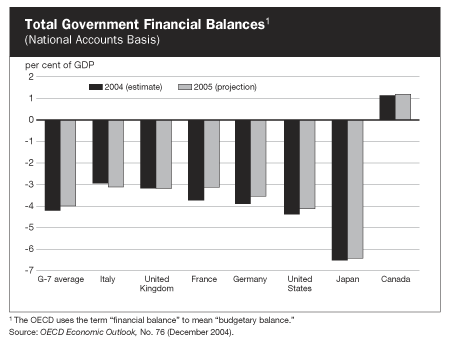
- Canada was the only G-7 country to record a surplus in 2004, according to OECD estimates of the total government sector[1] financial position on a National Accounts basis. This was the third consecutive year in which Canada was the only G-7 country in surplus.
- Canada is the only G-7 country to have recorded eight consecutive surpluses since 1960, the first year for which comparable international fiscal statistics are available from the OECD.
- Canada’s surplus for 2004 is estimated at 1.1 per cent of GDP, compared to an average deficit of 4.2 per cent in the G-7 countries.
- Moreover, Canada is expected to continue to be the only G-7 country to post a total government surplus in 2005 and 2006, according to the OECD.
Canada’s financial balance has improved significantly compared to the G-7 average
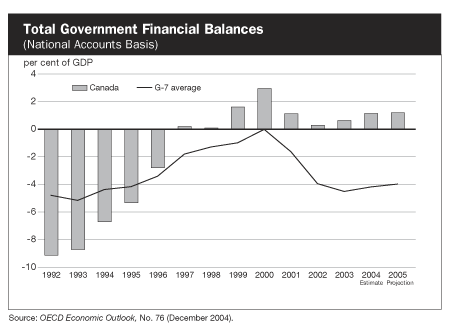
- Canada’s total government sector financial balance has improved substantially since 1992, when it was in deficit equal to 9.1 per cent of GDP, almost double the G-7 average.
- By 1997, fiscal improvements at all levels of government enabled Canada’s total government sector to move into surplus. Last year, Canada recorded its eighth consecutive budgetary surplus.
- Canada has registered the largest budgetary improvement of any G-7 country since its deficit peaked in 1992, registering a turnaround in its total government financial balance of more than 10 percentage points from 1992 to 2004.
- In contrast, the average financial balance of the G-7 countries is now similar to 1992 levels, despite improvements in the second half of the 1990s.
Canada’s program spending as a share of GDP is now below the G-7 average
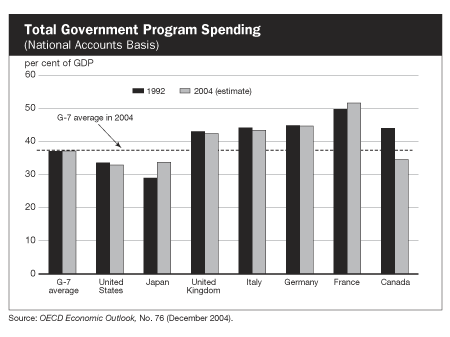
- The substantial turnaround in Canada’s financial position, as a percentage of GDP, is attributable in large part to a sharp reduction in program spending, i.e. all expenditures less public debt charges.
- Between 1992 and 2004, Canada’s total government program spending as a share of GDP is estimated to have been reduced by 9.4 percentage points. In contrast, the average for the G-7 countries remained virtually unchanged over this period.
- Canada’s program spending relative to GDP is below the G-7 average and the third lowest in the G-7, only slightly higher than in the United States and Japan. The OECD expects that this will continue in both 2005 and 2006.
Canada’s debt burden has declined from the second highest to the lowest among G-7 countries

- In the mid-1990s, Canada’s ratio of total government net financial liabilities to GDP was the second highest in the G-7. By 2003 Canada had the lowest ratio in the G-7.
- Since its peak in 1995, Canada’s ratio of total government net financial liabilities to GDP is estimated to have been reduced by 38.2 percentage points to 31.1 per cent of GDP in 2004, which was again the lowest in the G-7.
- The OECD estimates that this will continue in both 2005 and 2006. In contrast, the debt burdens of the other G-7 countries, with the exception of Italy, are projected to continue to increase.
Canada is one of very few countries with a sustainable public pension system
|
A Sustainable Public Pension System In 1997 measures were introduced to:
As a result of these reforms, on an actuarial basis, Canada’s public pension system is one of very few that is projected to be sustainable over at least the next 75 years. |
- International financial comparisons focus on the total government sector, which includes the federal, provincial-territorial and local governments as well as the CPP and QPP.[2]
- Although public pension systems around the world differ greatly, Canada is one of very few countries with an actuarially balanced public pension system.
- As a result of reforms in 1997, which increased the degree of pre-funding of the CPP/QPP and improved stewardship and accountability, the CPP/QPP is now actuarially sound for at least the next 75 years.
- As a result of improvements to Canada’s pension system and the substantial turnaround in the fiscal situation at both the federal and provincial levels, Canada’s ability to meet future fiscal challenges, including those associated with population aging, has improved significantly since the early 1990s.
The federal government in Canada has maintained a budgetary surplus since 1997–98, unlike the U.S.
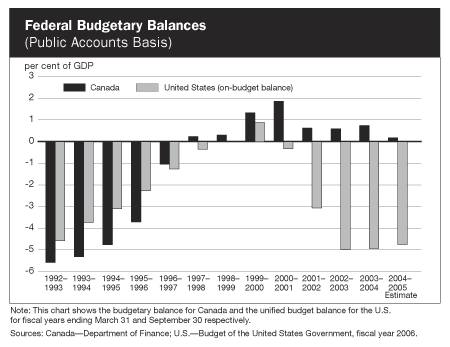
- The improved federal fiscal situation in Canada is in stark contrast to recent developments in the U.S. Like Canada, the U.S. federal government achieved a significant turnaround in its budgetary balance in the second half of the 1990s, moving from large deficits to surpluses. However, since 2000–01 the U.S. has returned to deficits whereas Canada has continued to record uninterrupted surpluses.
- The Canadian federal government posted a surplus of C$9.1 billion or 0.7 per cent of GDP in 2003–04, while the U.S. government incurred an "on-budget" deficit[3] of US$567 billion or 4.9 per cent of GDP. Even when Social Security surpluses are included, the U.S. "unified budget" deficit was US$412 billion, or 3.6 per cent of GDP in 2003–04.
- While the Canadian federal government is forecasting a surplus of C$3 billion in 2004–05, the U.S. on-budget deficit is expected to deteriorate to US$589 billion or 4.8 per cent of GDP (with a unified budget deficit of US$427 billion). The Administration does not project a return to balanced budgets for at least the next five years.[4]
The federal market debt-to-GDP ratio in Canada fell below that of the U.S. in 2003–04
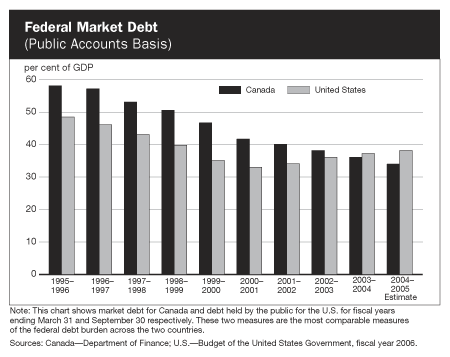
- As a result of continued surpluses at the federal level in Canada and the deterioration in U.S. federal finances, the federal market debt-to-GDP ratio in Canada fell below the U.S. figure in 2003–04 for the first time since 1977–78.
- The Canadian federal market debt-to-GDP ratio fell to 36.1 per cent in 2003–04, from almost 60 per cent in 1995–96, while the U.S. figure rose for the third consecutive year last year to 37.2 per cent.
- This gap is expected to widen in 2004–05 as the Canadian ratio is expected to fall to 34.0 per cent while the U.S. ratio is expected to rise to 38.6 per cent.
1 Canada’s total government sector includes the federal, provincial-territorial and local governments, as well as the Canada Pension Plan and Quebec Pension Plan. [Return]
2 The CPP and QPP are funded through payroll contributions and ensure a basic level of retirement income for all working Canadians. [Return]
3 The U.S. on-budget balance is more comparable with the Canadian federal budgetary balance because it excludes the pension surpluses of the U.S. Social Security system. The balance of the CPP is not included in the Canadian federal budgetary balance figures. [Return]
4 According to the Congressional Budget Office (CBO), the U.S. government will remain in deficit for at least the next 10 years. [Return]
- Table of Contents - Previous - Next -
|
|
|||||
| Last Updated: 2005-02-23 | |||||